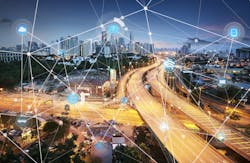Industry Influencer: Smart Spaces Powered by Dell Technologies
The continued advancement of technologies such as 5G, Internet of Things (IoT), connected devices, and social networks is resulting in an exponential growth of video data and the creation of digital citizens who have access to the information at their fingertips. These trends create the opportunity to manage the urban environment in smarter ways, and to create spaces that are dramatically more livable, workable, and sustainable.
As the industry moves to embrace smart space technologies, we need to understand the new data challenges associated with these projects. In this Influencer Q&A, Security Technology Executive’s editors explore with Dell Technologies, the drivers to implement a data-first strategy for tangible improvements for modern cities and communities. We review the challenges and how some spaces are preparing to manage the data coming from sensors and connected devices.The panelists will discuss how Dell Technologies is committed to providing its customers with fully integrated computer vision solutions delivering physical security, real-time situational awareness, and digital forensics. Going further, we review how Dell Technologies can help turn an organization’s data into actionable intelligence — better protecting people and property.
Meet the Dell Panel:
· Vince Ricco is a Business Development Manager for Unstructured Data Storage for Safety and Security at Dell Technologies who partners with industry-leading technology companies and relevant go-to-market channels to provide “Best of Breed” Safety and Security Solutions and Architectures.
· Wayne Arvidson is the Director of Market Development and Strategy, Safety and Security at Dell Technologies. Wayne has over 25 years of senior management experience in companies ranging from start-ups to Fortune 50 firms.
· Edward Hicks is the Business Development Manager for Safety Security, IoT, Edge, Analytics at Dell Technologies. He has over 35 years of experience as a technical innovator and consultant across a full range of technology. He currently has been leading Dell and its partners on Analytics Anywhere.
STE: As advanced technologies like 5G and an expanding IoT universe that is shifting data’s center of gravity to the edge, how can organizations address their physical security needs more efficiently and take a more proactive approach to mitigate risk through AI-enhanced solutions?
The growth of video data and the rise of real-time computer vision applications has created new perspectives on the edge-to-core strategy and a shift from a “Cloud First” agenda to a “Data First” mentality.
Here is a real-life example.
- Due to the high density of the video files and accompanying metadata, the initial video recordings will likely be localized with a workflow architecture to distribute the video and metadata based on policies.
o Using computer vision applications such as License Plate Recognition (LPR) to capture and store the license plate information ensures that there is no need for video retention which ultimately lowers the overall storage costs. The LPR analytics can log this information for future inspection as well.
- Not only the data is growing, but the value of the generated data is also increasing.
o Organizations need to retain greater amounts of video and analytics data for training purposes.
o If we take the example of the oil and gas industry, computer vision is used to protect assets, verify personnel proximity as well as safety compliance, and monitor visually verifiable system faults, thermal imaging cameras, and other environmental sensors.
These types of data collections and/or integrations have historically been hampered by data being “stranded” in the field or at the edge due to a lack of connectivity or edge processing capabilities. We are at an evolutionary point where with the intelligent edge, stronger compute plus distributed core-to-edge and application/utility advancements allow for data normalization layers or at least greater integration across these systems.
A “Data First” mentality will enable organizations to build a smart infrastructure based on the business value of data and ensure that the data is protected and available where and when they need it.
Arvidson: The real objective here is to create what we refer to as “real-time situational awareness”. The way that we do this is to start with the camera-based safety and security infrastructure, ingest video once into a converged or hyper-converged infrastructure, and then integrate other sensor data and enable multiple types of AI-enabled analytics to access that data in place, delivering results in close to real-time.
The other component of the solution is to have some of these AI-enabled analytics working at the edge so that we’re processing data as close to the source as possible. This combination provides security professionals with analyzed data more rapidly, eliminating the need for it to be visualized, interpreted, and then an action decided. It also means with automation and AI; the organizations can deploy their human resources in the field where they can have more impact and be more responsive.
Hicks: This capability brings a whole new level of Situational Awareness to the user, and with the addition of AI, and the ability to project into the future, the processing at the edge becomes more than just Situational Awareness,it becomes Actionable Augmented Intelligence that delivers predictive insights at speed.
STE: With the tsunami of data information organizations and public agencies deal with on a minute-per-minute basis, one of the more intriguing challenges is coordinating a reliable framework that can help harness the power of information and provide them a vehicle to create an actionable safety and security roadmap. Detail some best practices that facilitate a data-rich plan.
Ricco: I think there are a few significant plays in motion today with both having a common evolutionary tract. In most public sector and enterprise private sector environments, we see the increased adoption of digital systems (new technologies or digital replacements of legacy analog systems such as access control, HVAC, public address, etc.).
By way of example, if we look at most education campuses today, we see high adoption of IP-based video cameras, audio sensors (gunshot and or aggressive voice detectors), access control and lockdown controls, HVAC, fire and control systems, and of course mass notification systems.
An example of more integrated solutions that we see emerging today is seen in safe and smart campuses, public venues, and cities. Here the system can benefit and ROI is generated by increased efficiencies in operations, utility cost, and personnel optimizations. These integrated data sets also allow for a powerful collaboration between the public and private sectors such as citizen/attendee safety, smart traffic, and parking based on real-time usage data, elevated retail opportunities, and generally higher quality of life in these zones.
Hicks: One of the core tenets of this type of solution is the concept of “ingest once, access by many”. This is best accomplished by capturing the video to a converged or hyper-converged infrastructure which allows multiple applications to access the data without moving it across the network multiple times. This saves infrastructure bandwidth.
Another key element is the concept of keeping data on the most appropriate level of storage based on balancing performance and cost versus the need for the data. The goal is to keep real-time situational data on the highest performing tier, and as that data ages, move it to a lower, more cost-effective component. Also, retaining the data for longer periods of time than before allows for the visualization of patterns over time. The longer retention, the more refined and accurate the analysis.
This data migration is managed by the storage infrastructure, transparent to the end-user, so they can work in the application they are most familiar with as opposed to having to leave the app to do data management functions. They just see it as one big drive, no matter where it resides, and they always have access to it through their VMS or other apps directly. By utilizing this type of architecture, users can allow multiple applications to gain insights from the same set of data, add additional apps with no impact, and create centralized, user-configurable dashboards that allow them to see these insights in real-time to reduce time to action.
STE: As digital technologies continue to converge as well as critical network-driven infrastructure and devices merge into seamless and unified systems, what makes the migration to Smart Cities and Space technologies important to a secure and sustainable community landscape?
Ricco: As demonstrated by some of the examples above, as computing and communications capacities increase, organizations should focus on planning for the infrastructure (knowing which compute and storage options are available), researching best cost/performance options by application(s), and looking at investment protecting CapEx expenditures as well as leveraging consumption models which include both cloud and cloud-like consumption models for on-prem or Infrastructure-as-a-Service.
All of this is enabled by intelligent edge computing, a centralized infrastructure that provides access to the entire pool of data, coupled with a cloud-native strategy that enables us to quickly develop and deploy applications. When we add in the concept of “Analytics Anywhere”, it means that we’re moving the results of AI-based inferencing, not the data. We can improve the learning models utilized with real-time information and quickly deploy those improved models to the edge, continually improving the results that deliver a safer, smarter environment.
STE: The ongoing pandemic has energized the concept of “smart buildings”. From Dell Technologies’ perspective, what constitutes your vision of the smart building concept from both a technology and business operations standpoint, and how will that vision expand post-COVID-19?
Ricco: Pulling this back to an infrastructure capability and future-proofing perspective, the focus must be on meeting the compute and capacity needs for today as well as maintaining and expanding as you grow. This approach will enable organizations to utilize best practice workflows from edge to near edge to the data center (on-prem) to cloud.
The infrastructure should be able to accommodate both physical and virtualized compute, variable communications capability (wired and wireless), provide workflow architecture to store the right data in the right location in the most cost-effective manner to protect today’s investment with an eye on tomorrow.
Additionally, by utilizing our “Analytics Anywhere” architecture, we can do inferencing at the edge and provide better real-time situational awareness. We can send the results of that inferencing back to the central location -- not all the raw data -- so that we can update the learning models in close to real-time, which allows us to use the converged/hyper-converged infrastructure to push that updated, enhanced model back to the edge.
Integrating with other types of IoT sensors such as air quality, power, environmental, etc. allows us to combine the information coming out of those systems with the video data from the safety and security system to create much more actionable insights via an integrated command and control infrastructure. This strategy makes the facility not just safe, but also smart.
All of this comes together as we see safety and security working hand-in-hand with facilities and maintenance to create better operational efficiencies. This has become extremely important post-pandemic as many companies have realized tremendous savings while they had employees work from home, and now don’t want to go back to pre-pandemic building management costs.




